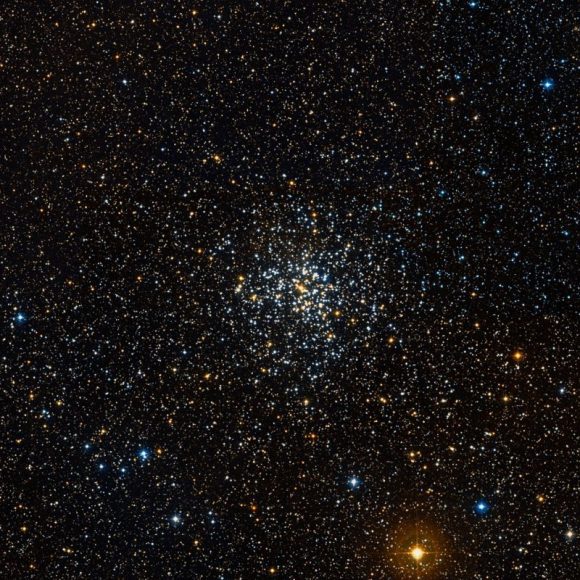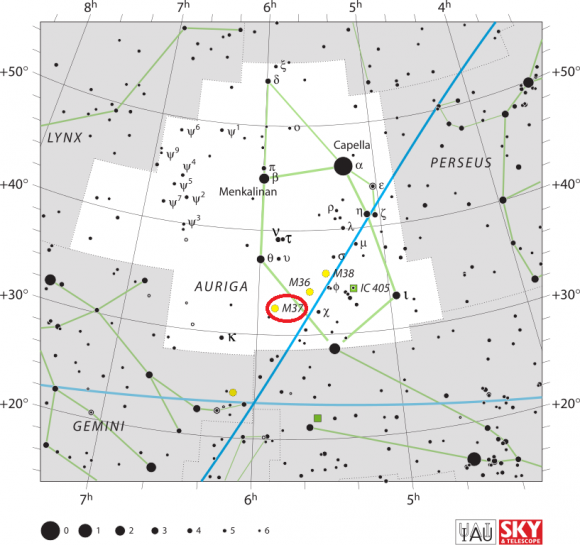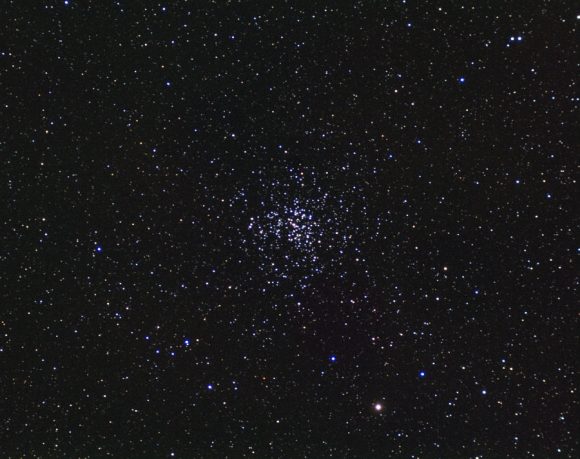Messier 37 – the NGC 2099 Open Star Cluster

During the 18th century, famed French astronomer Charles Messier noted the presence of several “nebulous objects” in the night sky. Having originally mistaken them for comets, he began compiling a list of them so that others would not make the same mistake he did. In time, this list (known as the Messier Catalog) would come to include 100 of the most fabulous objects in the night sky.
One of these objects is the open star cluster known as Messier 37 (aka M37 and NGC 2099). Located in the direction of the Auriga constellation, Messier 37 is one of three open star clusters (including Messier 36 and Messier 38) in this portion of the night sky – and also the brightest.
Description:
Of the trio of Messier star clusters in this area, M37 is by far the most stellar populated. It contains at least 150 stars that are around magnitude 12 and easily resolved by even small telescopes – and science is still counting actual members! At around 347 – 550 million years old, you’ll find at least a dozen red giants living here about 4,500 light years away from Earth… and they do it in a neighborhood that spans anywhere from 20 to 25 light years across!
Just how many stars might be inside this intermediate-aged cluster? As R. Sagar and Nilakshi of the Indian Institute for Astrophysics said in their 2002 study:
“The CCD observations of the rich open star cluster NGC 2099 and its surrounding field region have been carried out up to a limiting magnitude of V ~ 22 mag in B, V and I passbands for the first time. A total of ~ 12 000 stars have been observed in the area of about 24 arcmin x 34 arcmin in the cluster region, as well as ~ 2180 stars in the ~ 12arcmin x 12arcmin area of the field region located ~ 45arcmin away from the cluster center.”
Out of this huge number of stars, astronomers have been able to observe white dwarfs, too. This helps us to understand how they develop and what affects their helium or hydrogen content. Jasonjot Singh Kalirai et al. had the following to say in a 2004 study:
“Spectra have been obtained of 21 white dwarfs (WDs) in the direction of the young, rich open star cluster NGC 2099. This represents an appreciable fraction (>30%) of the cluster’s total WD population. The mean derived mass of the sample is 0.8 M—about 0.2 M larger than the mean seen among field WDs. A surprising result is that all of the NGC 2099 WDs have hydrogen-rich atmospheres (DAs); none exhibit helium-rich ones (DBs) or any other spectral class. We explore possible reasons for the lack of DBs in these clusters and conclude that the most promising scenario for the DA/DB number ratio discrepancy in young clusters is that hot, high-mass WDs do not develop large enough helium convection zones to allow helium to be brought to the surface and turn a hydrogen-rich WD into a helium-rich one.”
So, we’re setting the stage with number of stars and types. We have white dwarfs – but what about variables? Y.B. Kang (et al), put it this way in a 2007 study:
“Time-series CCD photometric observations of the intermediate-age open cluster NGC 2099 were performed to search for variable stars. We also carried out BV photometry to study physical properties of variables in the cluster. Using V-band time-series data, we carefully examined light variations of about 12,000 stars in the range of 10 < V < 22 mag. A total of 24 variable stars have been identified; seven stars are previously known variables and 17 stars are newly identified. On the basis of observational properties such as light curve shape, period, and amplitude, we classified the new variable stars as nine delta Scuti-type pulsating stars, seven eclipsing binaries, and one peculiar variable star. Judging from the position of delta Scuti-type stars in the color-magnitude diagram, only two stars are likely to have the cluster membership. One new variable KV10 shows peculiar light variations with a delta Scuti-type short period of about 0.044 day as well as a long period of 0.417 day.”
So what does knowing about these two types of stars help with our understanding of stellar evolution? That’s one of the goals of the RACE-OC project. As S. Messina (et al) said in 2008:
“Rotation and solar-type magnetic activity are closely related to each other in main-sequence stars of G or later spectral types. The presence and level of magnetic activity depend on star’s rotation, and rotation itself is strongly influenced by strength and topology of the magnetic fields. Open clusters represent especially useful targets to investigate the connection between rotation and activity. The open cluster NGC 2099 has been studied as a part of the RACE-OC project (Rotation and ACtivity Evolution in Open Clusters), which is aimed at exploring the evolution of rotation and magnetic activity in the late-type members of open clusters of different ages. We collected time series CCD photometric observations of this cluster in January 2004, and we determined the presence of periodicities in the flux variation related to the stellar rotation by Fourier analysis. We investigate the relations between activity manifestations, such as the light curve amplitude, and global stellar parameters. Results: We have discovered 135 periodic variables, 122 of which are candidate cluster members. Determination of rotation periods of G- and K-type stars has allowed us to better explore the evolution of angular momentum at an age of about 500 Myr. In our analysis, we have also identified 3 new detached eclipsing binary candidates among cluster members. A comparison with the older Hyades cluster (~625 Myr) shows that the newly-determined distribution of rotation periods is consistent with the scenario of rotational braking of main-sequence spotted stars as they age. However, a comparison with the younger M 34 cluster (~200 Myr) shows that the G8-K5 members of these clusters have the same rotation period distribution. That is, G8-K5 members in NGC 2099 seem to have experienced no significant braking in the age range from ~200 to ~500 Myr. Finally, NGC 2099 members have a smaller level of photospheric magnetic activity, as measured by light curve amplitude, than in younger stars of the same mass and rotation, suggesting that the activity level also depends on some other age-dependent parameters.”
History of Observation:
Although this great star cluster was originally recorded Giovanni Batista Hodierna before 1654, it would be 230 years before his records would be uncovered, so when Charles Messier first logged as Messier 37, it was believed to be an independent discovery.
“In the same night [September 2 to 3, 1764], I have observed a second cluster of small stars which were not very distant from the preceding, near the right leg of Auriga and on the parallel of the star Chi of that constellaiton: the stars there are smaller than that of the preceding cluster: they are also closer to each other, and contain a nebulosity. With an ordinary refractor of 3 feet and a half, one has difficulty to see these stars; but one distinguishes them with an instrument of greater effectivity. I have determined the position fo this cluster, which may have an extension of 8 to 9 minutes of arc: its right ascension was 84d 15′ 12″, and its declination 32d 11′ 51″ north.”
While William Herschel would return in later years to study Messier’s object, he did not publish his notes – but gives some great observing advice:
“A useful, coarse step; it will serve to learn to see nebulae, because it contains many small stars mixed with others in various magnitudes, many of which are not to be seen without great and long attention.” Messier 37 would be later given its NGC catalog designation by John Herschel who was the first to make a guess at its true stellar population: “Very fine large cluster, all resolved into stars of 10th to 13th magnitude. It fills 1 1/2 field, but the straggling stars extend very far. There may be 500 stars.”
As always, Admiral Smyth was the most poetical about his observing, and of M37 he writes:
“A magnificent object, the whole field being strewed as it were with sparkling gold-dust; and the group is resolvable into about 500 stars, from the 10th to the 14th magnitudes, besides the outliers. It was found and fixed by Messier in 1764, who described it as “a mass of small stars, much enveloped in nebulous matter.” This nebulous matter, however, yields to my telescope, and resolves into infinitely minute points of lucid light, among the distinct little individuals.”

The location of Messier 37 in the constellation Auriga. Credit: IAU and Sky & Telescope magazine (Roger Sinnott & Rick Fienberg)
Locating Messier 37:
Locating Messier 37 is relatively easy once you understand the constellation of Auriga. Looking roughly like a pentagon in shape, start by identifying the brightest of these stars – Capella. Due south of it is the second brightest star which shares its border with Beta Tauri, El Nath. By aiming binoculars at El Nath, go north about 1/3 the distance between the two and enjoy all the stars! You will note two very conspicuous clusters of stars in this area, and so did Le Gentil in 1749.
Binoculars will reveal the pair in the same field, as will telescopes using lowest power. The dimmest of these is the M38, and will appear vaguely cruciform in shape. At roughly 4200 light years away, larger aperture will be needed to resolve the 100 or so fainter members. About 2 1/2 degrees to the southeast (about a finger width) you will see the much brighter M36.
More easily resolved in binoculars and small scopes, this “jewel box” galactic cluster is quite young and about 100 light years closer. If you continue roughly on the same trajectory about another 4 degrees southeast you will find open cluster M37. This galactic cluster will appear almost nebula-like to binoculars and very small telescopes – but comes to perfect resolution with larger instruments.
While all three open star clusters make fine choices for moonlit or light polluted skies, remember that high sky light means less faint stars which can be resolved – robbing each cluster of some of its beauty. Messier 37 is the brightest and easternmost of the trio and you’ll very much notice its density.
When you view this cluster with binoculars, you’ll be seeing it much as Messier did… But use the power of a telescope if you can. Because this cloud of stars is quite worth your time and attention!
Object Name: Messier 37
Alternative Designations: M37, NGC 2099
Object Type: Galactic Open Star Cluster
Constellation: Auriga
Right Ascension: 05 : 52.4 (h:m)
Declination: +32 : 33 (deg:m)
Distance: 4.4 (kly)
Visual Brightness: 6.2 (mag)
Apparent Dimension: 24.0 (arc min)
We have written many interesting articles about Messier Objects here at Universe Today. Here’s Tammy Plotner’s Introduction to the Messier Objects, , M1 – The Crab Nebula, M8 – The Lagoon Nebula, and David Dickison’s articles on the 2013 and 2014 Messier Marathons.
Be to sure to check out our complete Messier Catalog. And for more information, check out the SEDS Messier Database.
Sources:
The post Messier 37 – the NGC 2099 Open Star Cluster appeared first on Universe Today.
Universe Today
Go to Source
Powered by WPeMatico
